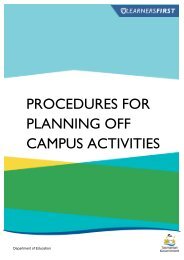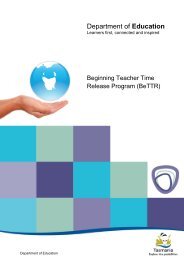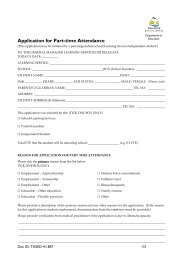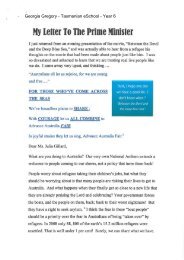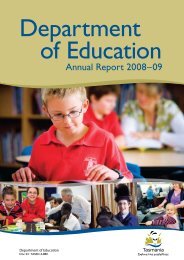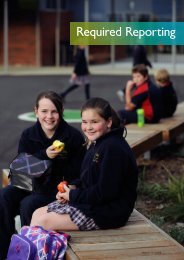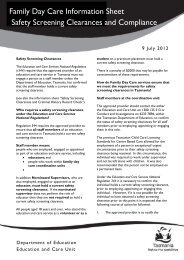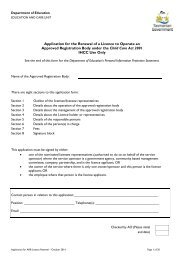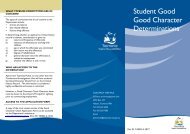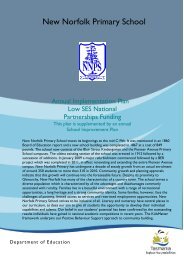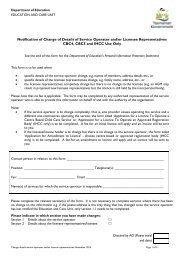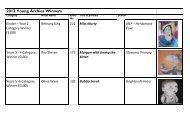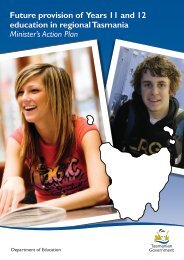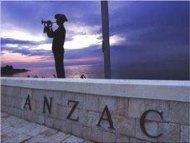Department of Education
DoE Annual Report 2010-2011 - Department of Education
DoE Annual Report 2010-2011 - Department of Education
- No tags were found...
You also want an ePaper? Increase the reach of your titles
YUMPU automatically turns print PDFs into web optimized ePapers that Google loves.
GOAL 6: Dynamic, creative and internationally recognised arts community and culture<br />
Standard 6.3: Promote awareness <strong>of</strong> Tasmania’s multicultural past and present<br />
6.3.2 Number <strong>of</strong> schools integrating multicultural perspectives in the curriculum<br />
Primary<br />
Implementation<br />
Program<br />
In 2011, 109 primary schools <strong>of</strong>fered a language program in Chinese, French, German, Indonesian, Italian or<br />
Japanese. These programs incorporate an intercultural language learning approach.<br />
Studies <strong>of</strong> Asia<br />
Agreements<br />
to support<br />
intercultural<br />
approaches<br />
Studies <strong>of</strong> Asia is integral to Asian languages programs and work continued to integrate this area across the<br />
curriculum, particularly in the area <strong>of</strong> the arts. A number <strong>of</strong> schools have established connections with overseas<br />
sister schools, sharing aspects <strong>of</strong> arts, language and culture.<br />
Australian Curriculum schools are being encouraged to embed Studies <strong>of</strong> Asia as a cross-curriculum priority <strong>of</strong> the<br />
new Australian Curriculum.<br />
The department has agreements and relationships with a range <strong>of</strong> countries to support the learning and teaching<br />
<strong>of</strong> their languages and cultures in Tasmanian schools. These include the Goethe Institute, the French Embassy,<br />
the Italian Government, the Japan Foundation, the Consulate General <strong>of</strong> the Republic <strong>of</strong> Indonesia and the<br />
Chinese Consulate General.<br />
Contribution towards the benchmark<br />
Tasmania is an increasingly diverse society, with a wide range <strong>of</strong> cultures. The department is committed to<br />
increasing respect for our multicultural heritage and promotes a number <strong>of</strong> initiatives that schools can access<br />
to further support multicultural education across Tasmania. In 2010, 82.1%* <strong>of</strong> schools integrated multicultural<br />
perspectives into their curriculum, this is an increase from the 2009 figure <strong>of</strong> 81.0%.<br />
* All colleges <strong>of</strong> the Tasmanian Academy, and the Tasmanian Polytechnic were not included in 2010 data collection but will be<br />
reported in next year’s data collection.<br />
Standard 6.5: Identify, conserve and present significant representations <strong>of</strong> the built and<br />
movable heritage and cultural landscapes<br />
6.5.1 Number <strong>of</strong> enrolments in cultural heritage courses (Skills Tasmania) **<br />
Contribution towards the benchmark<br />
Cultural heritage courses were available through the University <strong>of</strong> Tasmania and the VET system. Higher<br />
education courses included higher degree, postgraduate and undergraduate courses in Architecture,<br />
Environmental Design, Tourism (History and Heritage units), and Law (Heritage Law units).<br />
VET institute courses were for architects, librarians, archivists, historians, conservators, museum or gallery<br />
curators, architectural associates, library technicians, museum or art gallery technicians, library assistants, and<br />
museum or gallery attendants.<br />
In 2010, 837 participants undertook cultural heritage courses, which is below the 2010 target <strong>of</strong> 1,000. However,<br />
this was an increase on the 2009 figure <strong>of</strong> 781 indicating that participation is moving in the right direction.<br />
** Skills Tasmania is a separate statutory authority and is responsible for progress against this initiative.<br />
6.5.2 Percentage <strong>of</strong> significant items conserved<br />
Contribution towards the benchmark<br />
Preventing the deterioration <strong>of</strong> cultural heritage items remains an important focus for LINC Tasmania.<br />
The 2010–11 treatment program for priority government records included: Lower Court records; 150 Public<br />
Works <strong>Department</strong> plans; items from the Convict series; the Gaol <strong>Department</strong>, the Supreme Court and Lands<br />
<strong>Department</strong> registers.<br />
Non-government records included the newly acquired photographic material from the Mt Lyell Mining Company;<br />
Gustav Weindorfer letters; records from St. George’s Church and photographs from the Trinity Bellringers.<br />
Heritage collections work included exhibition and displays implementing current conservation standards;<br />
treatment <strong>of</strong> new acquisitions such as J. C. Goodhart prints and the rehousing <strong>of</strong> The Cruise <strong>of</strong> the Beacon by<br />
Bishop Nixon.<br />
Appendices – Tasmania Together Activity Report – Goal 6<br />
143



